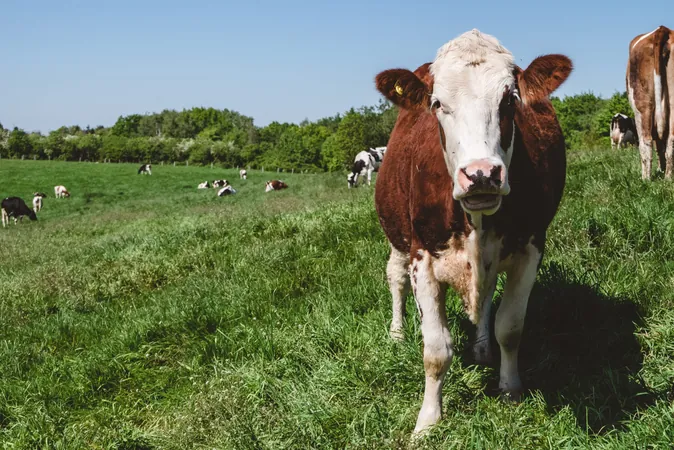
Are Cows the Next Transmission Hotspot for Bird Flu? Here’s What You Need to Know!
2025-01-20
Author: Michael
Introduction
Bird flu has been a longstanding challenge for the poultry industry, wreaking havoc on bird populations including chickens, ducks, and geese for over a century. Caused by an influenza virus variant similar to those that affect humans, bird flu is classified with four distinct variants, with type A leading the charge in potential health threats due to its ability to jump from animals to humans, raising fears of a future pandemic.
Unusual Symptoms in Cattle
In an alarming discovery in early February 2024, researchers from the Centers for Disease Control and Prevention (CDC) began investigating reports of dairy cattle exhibiting strange symptoms. These symptoms included a lack of appetite, reduced milk output, and a peculiar thick, yellowish milk. The sickened cows showed worsened symptoms within 4 to 6 days, which gradually improved over the next two weeks.
Rising Concerns
However, by March 2024, reports flooded in from dairy farms in Kansas and New Mexico about similar sick cows, but this time, there were fatalities among local wildlife, including birds and cats. The situation escalated the researchers' concern about a possible zoonotic disease—one that could jump from animals to humans, potentially triggering a new health crisis.
Investigation and Findings
Researchers quickly mobilized to a Texas dairy farm known to have sick cows, collecting vital samples from six deceased cows and two cats (of 24 onsite that had been consuming unpasteurized cow milk). Shockingly, over half of those cats died within days of the cows first showing symptoms. This critical investigation aimed to discern whether the cats shared the same dangerous viral affliction.
Upon inspection, signs of illness were not overtly visible—save for some lesions on the mammary glands of two cows. Yet, the researchers suspected the presence of viral material in the tissues, leading them to utilize polymerase chain reaction (PCR) techniques to detect viral DNA or RNA. The results were astonishing: traces of the avian influenza virus were discovered in both the cows’ milk and the cats’ samples, confirmed by the USDA National Veterinary Services Laboratory.
Digestive Issues and Genetic Analysis
Intrigued and concerned, the research team's next step was to delve into why the cows displayed such unusual digestive issues along with the milk production decline. Investigations revealed that the cows were suffering from undigested food and small stomach ulcers. The tissue samples from the cows with mammary lesions exhibited elevated white blood cell counts, indicating a possible path where the virus traveled from the stomach straight to the mammary glands.
What’s more, the genetic analysis of the viral DNA from the infected cows and cats revealed concerning similarities, with two crucial gene sequences—HA and NA—showing near-identical sequences across samples, even among different dairy farms in Texas. This raised alarms that this specific strain of the virus was moving rapidly among cattle throughout the region.
Conclusion and Public Health Implications
The findings have underscored the potential cross-species transmission of bird flu, although the exact mechanism remains a puzzle. It's believed that the cows were infected through contact with wild bird droppings, while the cats likely contracted it by consuming the infected milk. To challenge this emerging threat, experts are now strongly advising the public to steer clear of unpasteurized milk.
The urgency for more research is palpable, as scientists stress that effective testing and immediate action are crucial for dairy cattle exhibiting symptoms like reduced appetite or milk production. Proactive measures could prevent further outbreaks and keep this potentially grave situation at bay.
Stay tuned as we continue to monitor this developing situation—our health could depend on it!









 Brasil (PT)
Brasil (PT)
 Canada (EN)
Canada (EN)
 Chile (ES)
Chile (ES)
 Česko (CS)
Česko (CS)
 대한민국 (KO)
대한민국 (KO)
 España (ES)
España (ES)
 France (FR)
France (FR)
 Hong Kong (EN)
Hong Kong (EN)
 Italia (IT)
Italia (IT)
 日本 (JA)
日本 (JA)
 Magyarország (HU)
Magyarország (HU)
 Norge (NO)
Norge (NO)
 Polska (PL)
Polska (PL)
 Schweiz (DE)
Schweiz (DE)
 Singapore (EN)
Singapore (EN)
 Sverige (SV)
Sverige (SV)
 Suomi (FI)
Suomi (FI)
 Türkiye (TR)
Türkiye (TR)
 الإمارات العربية المتحدة (AR)
الإمارات العربية المتحدة (AR)